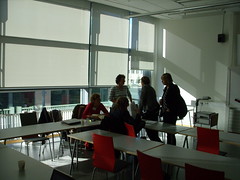
The discussion continues
Originally uploaded by keibr
I work with the professional development of teachers and if I can start with a slight criticism it is of Tuomi’s view of future learning environments. He seems to be very sure of the future. In the final paragraph on page 5 we find that; “…educational systems will be redesigned…Education and learning will be integrated…will shift the focus towards adult education…” All this is possible and there are already educational organisations and networks moving towards this future. However, I feel that all this will only happen if governments encourage the redesign of educational systems in this direction, change the direction of teacher education and the professional development of working teachers. Otherwise the result will be islands of development in a sea of traditional (outmoded?) education models. Of course, this report, prepared for the OECD and this course are a part of that encouragement!
I found the “Open resources” section particularly interesting. (pages 25 -28). However, Tuomi describes three hierarchical levels of openess (P26) but I am not sure these levels are entirely hierarchical. As I see it a resource can fulfil the requirements of openness 1 and 3, but not the requirements of 2. The resource is accessible (level 1) and available for modification, repackaging etc (level 3), but the user still cannot “access all the services generated” (level 2). Rosemarie discussed this point with a slightly different focus.
For me the position of non-commercial activities with regard to the market is interesting and I feel Tuomi does not really take up this question beyond mentioning that it is;
“…a tricky one. As non-commercial typically means either that no commercial players have current interest in the activities, or that society has structured the markets so that some things are not provided by commercial actors.” (p 32).
In some cases this feels correct. For example the creative commons section of Flickr makes millions of images available to non-commercial users, but it is unlikely that these users would have purchased pictures commercially if Flickr did not exist. However, in other cases I feel certain that the “new” non-commercial activities have an effect upon the market. As JLH writes in OER Chatter; “OER savings could allow financially challenged districts to cut educational material expenditures so that money could be allocated elsewhere in the system.” The publishers of text books will not be happy if they are replaced by OERs!
As this report made clear tomorrow's educational world will look very different to today's. I hope the predictions made in the report are fulfilled and it will be interesting to help in making that future.
1 comment:
Hi Keith:
Your comments are well taken. Thanks for raising the language issue. Given that my first language is English, I am often not aware of the difficulties that others face. I speak French also and I noted that Rice Connections had a number of resources written in French.
This may be your opportunity to present OER to Sweden big time. If you started a translation project I am certain other Swedes would join in the project. At LeMill, you could download their resource on your own server and begin there. I hope that you will determine to fill this need.
Stewjean
Post a Comment